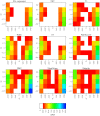Fine-scale patterns of population stratification confound rare variant association tests
- PMID: 23861739
- PMCID: PMC3701690
- DOI: 10.1371/journal.pone.0065834
Fine-scale patterns of population stratification confound rare variant association tests
Abstract
Advances in next-generation sequencing technology have enabled systematic exploration of the contribution of rare variation to Mendelian and complex diseases. Although it is well known that population stratification can generate spurious associations with common alleles, its impact on rare variant association methods remains poorly understood. Here, we performed exhaustive coalescent simulations with demographic parameters calibrated from exome sequence data to evaluate the performance of nine rare variant association methods in the presence of fine-scale population structure. We find that all methods have an inflated spurious association rate for parameter values that are consistent with levels of differentiation typical of European populations. For example, at a nominal significance level of 5%, some test statistics have a spurious association rate as high as 40%. Finally, we empirically assess the impact of population stratification in a large data set of 4,298 European American exomes. Our results have important implications for the design, analysis, and interpretation of rare variant genome-wide association studies.
Conflict of interest statement
Figures






References
-
- Ziv E, Burchard EG (2003) Human population structure and genetic association studies. Pharmacogenomics 4: 431–441. - PubMed
-
- Clayton DG, Walker NM, Smyth DJ, Pask R, Cooper JD, et al. (2005) Population structure, differential bias and genomic control in a large-scale, case-control association study. Nat Genet 37: 1243–1246. - PubMed
-
- Helgason A, Yngvad’ottir B, Hrafnkelsson B, Gulcher J, Stef’ansson K (2004) An Icelandic example of the impact of population structure on association studies. Nat Genet 37: 90–95. - PubMed
Publication types
MeSH terms
Grants and funding
- RC2 HL102923/HL/NHLBI NIH HHS/United States
- RC2 HL102926/HL/NHLBI NIH HHS/United States
- RC2 HL-102926/HL/NHLBI NIH HHS/United States
- RC2 HL-102923/HL/NHLBI NIH HHS/United States
- UL1 TR000439/TR/NCATS NIH HHS/United States
- 090532/WT_/Wellcome Trust/United Kingdom
- RC2 HL-102925/HL/NHLBI NIH HHS/United States
- RC2 HL103010/HL/NHLBI NIH HHS/United States
- RC2 HL-102924/HL/NHLBI NIH HHS/United States
- RC2 HL102924/HL/NHLBI NIH HHS/United States
- R01 AG008122/AG/NIA NIH HHS/United States
- RC2 HL-103010/HL/NHLBI NIH HHS/United States
- RC2 HL102925/HL/NHLBI NIH HHS/United States
LinkOut - more resources
Full Text Sources
Other Literature Sources

